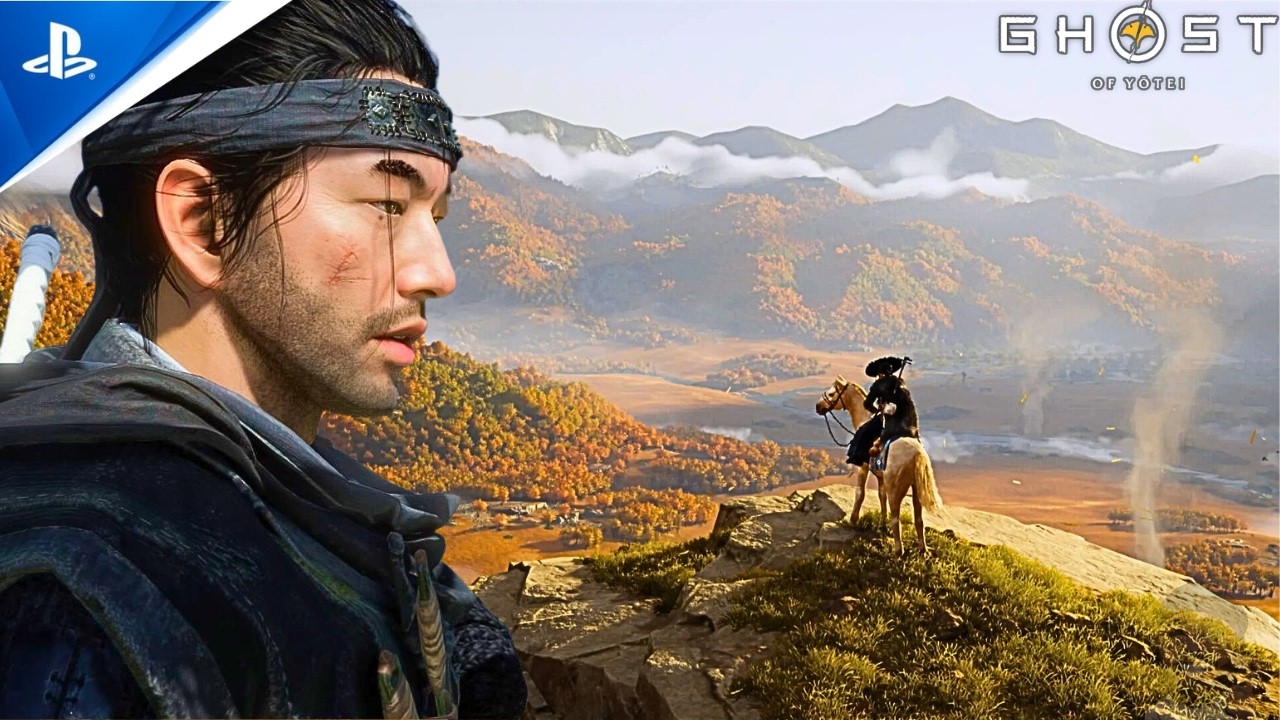🚨 GHOST OF YŌTEI IS SET TO OUTSHINE TSUSHIMA! 🗡️🌄
Samurai fans, brace yourselves! Ghost of Yōtei is coming to SLAY, promising to surpass Ghost of Tsushima with a fierce new hero, stunning landscapes, and next-level gameplay! 😱 Will Atsu’s quest for vengeance redefine the Ghost legacy? Can the snowy peaks of Mount Yōtei top Tsushima’s beauty? Dive into the hype and find out why this sequel is about to steal the spotlight! 👀

Sucker Punch Productions’ Ghost of Tsushima (2020) captivated gamers with its breathtaking open world, gripping samurai narrative, and polished combat, earning it critical acclaim and a devoted fanbase. Now, its standalone sequel, Ghost of Yōtei, set for release on October 2, 2025, for the PlayStation 5, promises to elevate the franchise to new heights. Featuring a new protagonist, Atsu, a fresh setting in Ezo (modern-day Hokkaido), and gameplay refinements, Yōtei aims to surpass its predecessor in narrative depth, environmental variety, combat innovation, and player freedom. This article explores how Ghost of Yōtei is poised to outshine Ghost of Tsushima in several key aspects, potentially redefining the action-adventure genre.
A More Complex Protagonist: Atsu’s Vengeful Journey
One of Ghost of Yōtei’s most significant upgrades is its protagonist, Atsu, a female ronin who adopts the persona of the onryō, a vengeful spirit from Japanese folklore. Unlike Jin Sakai, whose journey in Tsushima balanced honor with rebellion to save his island from Mongol invaders, Atsu’s story is deeply personal, driven by “underdog vengeance” against the Yōtei Six, a gang of outlaws who slaughtered her family and left her for dead. This shift from Jin’s noble cause to Atsu’s morally ambiguous quest adds layers of complexity, promising a narrative that challenges players to grapple with the ethics of revenge.
Atsu’s identity as a female ronin in 1603 Japan, during the early Edo period, introduces societal dynamics that Jin never faced. As a woman in a male-dominated society, Atsu may encounter prejudice or skepticism, potentially influencing gameplay through creative infiltration mechanics or relationship-building challenges. Her status as a ronin—an outcast samurai—further distinguishes her from Jin, who carried the prestige of Clan Sakai. This underdog perspective could make Atsu’s triumphs more emotionally resonant, as players witness her rise from tragedy to power. By focusing on a new hero with a darker, more personal narrative, Yōtei aims to surpass Tsushima’s character-driven storytelling.
A Stunning New Setting: Mount Yōtei’s Diverse Landscapes
Ghost of Tsushima’s island setting, with its vibrant forests, swamps, and mountains, was a visual masterpiece, but its 40 biomes sometimes felt repetitive due to the island’s limited microclimates. Ghost of Yōtei counters this with a new setting: the rugged environs of Mount Yōtei in Ezo, a region known for its four distinct seasons and diverse landscapes. The reveal trailer showcases snow-covered peaks, lush greenlands, dense forests, and bustling settlements, suggesting a map that could rival or exceed Tsushima’s scope. The iconic Mount Yōtei, looming over the landscape, promises to be a striking centerpiece, akin to Elden Ring’s Erdtree.
The introduction of dynamic weather effects—snow, rain, and auroras inspired by Hokkaido’s real environment—adds immersion and variety. Unlike Tsushima’s humid subtropical climate, Ezo’s four seasons could tie into gameplay, with snowstorms affecting stealth or spring rains altering combat dynamics. While Tsushima’s world was criticized for repetitive side activities, Yōtei aims to address this with a less repetitive open world, as confirmed by creative director Nate Fox. New activities like sumi-e painting and campsite interactions, alongside returning favorites like onsen bathing, suggest a richer, more varied exploration experience that could surpass Tsushima’s environmental design.
Enhanced Gameplay: Combat and Player Freedom
Ghost of Tsushima’s combat was a highlight, blending samurai duels with stealthy “Ghost” tactics, but its boss fights and stance-based mechanics were sometimes predictable. Ghost of Yōtei aims to evolve this system with a diverse arsenal and refined mechanics. Atsu wields dual katanas, a kusarigama, tanegashima (matchlock muskets), and a kaginawa (grappling hook), offering varied tactical approaches. These weapons replace Tsushima’s stance system, potentially allowing more fluid combat without the rigid rock-paper-scissors structure that frustrated some players. For example, dual-wielding katanas could enable faster, more aggressive playstyles, while the kusarigama adds long-range stealth options.
The game also introduces a quick-swap armor loadout system, addressing Tsushima’s tedious menu navigation for gear changes. By pressing a single button, players can switch between builds optimized for stealth, combat, or exploration, streamlining gameplay. Additionally, Yōtei emphasizes player freedom, with a non-linear quest structure allowing players to tackle the Yōtei Six in any order. This flexibility, combined with side activities like bounty hunting and new cinematic modes inspired by Takashi Miike and Shinichirō Watanabe, suggests a more dynamic and replayable experience than Tsushima’s linear campaign.
Boss fights, a weak point in Tsushima due to their repetitive nature, are set to improve in Yōtei. The game could feature multi-phase encounters with distinct mechanics, drawing inspiration from soulslike titles like Sekiro: Shadows Die Twice. Each member of the Yōtei Six—named Snake, Oni, Kitsune, Spider, Dragon, and Lord Saitō—may have unique personalities and fighting styles, making battles more memorable. For instance, a deceptive assassin could use smoke bombs, while a brute might wield a massive hammer, challenging players to adapt strategically.
Narrative Depth: A Darker, More Ambitious Story
Ghost of Tsushima romanticized the Ghost as a symbol of rebellion for the greater good, but Ghost of Yōtei takes a bolder approach by exploring the darker side of the Ghost persona. Atsu’s vengeance-driven narrative risks portraying the Ghost as a force for personal gain rather than honor, potentially forcing players to question her actions. This moral ambiguity, combined with the 329-year time jump to 1603, allows Yōtei to craft a fresh story unburdened by Tsushima’s Mongol invasion backdrop. The Edo period setting, with its political upheaval and ronin culture, provides a rich context for Atsu’s journey, possibly involving conflicts with the Tokugawa shogunate or Ainu natives.
The game’s focus on player choice, confirmed to be more prominent than in Tsushima, could lead to branching narrative paths, especially in how Atsu confronts the Yōtei Six. Side missions, which were sometimes repetitive in Tsushima, are set to be more varied, with activities like hunting outlaws adding depth. The return of Legends mode in 2026 as a free co-op update further enhances Yōtei’s longevity, offering story-driven missions and survival matches inspired by Japanese mythology. By weaving a darker, more flexible narrative with robust multiplayer, Yōtei aims to surpass Tsushima’s storytelling and replayability.
Technical and Artistic Advancements
Built natively for the PS5, Ghost of Yōtei leverages the console’s power for lightning-fast load times, 3D spatial audio, and enhanced visuals. The trailer’s stunning graphics, from snow-dusted ridges to vibrant wildflower fields, suggest a visual leap over Tsushima, which was a PS4 title. The PS5 Pro’s potential to enhance Yōtei’s fidelity further raises the bar. New cinematic modes, including Kurosawa, Miike, and Watanabe, add artistic flair, though some critics argue they oversimplify iconic directors’ styles. These technical advancements, combined with Sucker Punch’s commitment to authenticity (inspired by visits to Hokkaido), position Yōtei to outshine Tsushima’s already-impressive presentation.
Challenges and Expectations
Despite its promise, Yōtei faces challenges. Some fans worry it may feel too similar to Tsushima, with early gameplay footage suggesting familiar camera work and animations. The live-service-like elements of Legends mode must avoid the pitfalls of games like Marvel’s Avengers, ensuring fair monetization. Additionally, the shift to a new protagonist and setting risks alienating fans attached to Jin Sakai. However, Sucker Punch’s track record and focus on player feedback suggest they’re addressing Tsushima’s shortcomings, such as repetitive side content and predictable boss fights.
Fan expectations are sky-high, fueled by Tsushima’s success and Yōtei’s nomination for Most Anticipated Game at The Game Awards 2024. The game must balance innovation with the series’ core identity—feudal Japan’s romance and samurai combat—while delivering a fresh experience. If Yōtei nails its ambitious vision, it could redefine the Ghost franchise as an anthology, much like Assassin’s Creed, paving the way for future stories.
Conclusion: A New Ghost to Haunt the Genre
Ghost of Yōtei is poised to surpass Ghost of Tsushima by introducing a complex protagonist, a visually stunning and varied setting, refined gameplay, and a darker, more ambitious narrative. Atsu’s vengeance-fueled journey, the dynamic landscapes of Mount Yōtei, and innovations like non-linear quests and enhanced combat mechanics promise a richer experience. While challenges like fan expectations and potential similarities to Tsushima loom, Sucker Punch’s commitment to quality and player freedom suggests Yōtei could redefine the action-adventure genre. As the release date approaches, one thing is clear: Atsu’s legend is ready to eclipse Jin’s, forging a new path for the Ghost.





